课程:宋红康 JAVA
File类的使用
概述:
- java.io.File类:文件和文件目录路径的抽象表示形式,与平台无关.
- File能新建、删除、重命名文件和目录,但File不能访问文件内容本身。如果需要访问文件内容本身,则需要使用输入/输出流。
- 想要在Java程序中表示一个真实存在的文件或目录,那么必须有一个File对象,但是Java程序中的一个File对象,可能没有一个真实存在的文件或目录。
- 后续File类的对象常会作为参数传递到流的构造器中,指明读取或写入的”终点”.
常用构造器
public File(String pathname):以pathname为路径创建File对象,可以是绝对路径或者相对路径,如果pathname是相对路径,则默认的当前路径在系统属性user.dir中存储。- 绝对路径:是一个固定的路径,从盘符开始——相对于当前module
- 相对路径:是相对于某个位置开始
public File(String parent,String child):以parent为父路径,child为子路径创建File对象。,public File(File parent, String child):根据一个父File对象和子文件路径创建File对象
//这里只是创建对象,未必存储文件或者存在该目录
@Test
public void test1(){
//构造器1
File file1 = new File("hello.txt");//相对于当前module
File file2 = new File("D:\\IO\\he.txt");
System.out.println(file1);
System.out.println(file2);
//构造器2:
File file3 = new File("D:\\IO","he.txt");
System.out.println(file3);
//构造器3:
File file4 = new File(file3,"hi.txt");
System.out.println(file4);
}

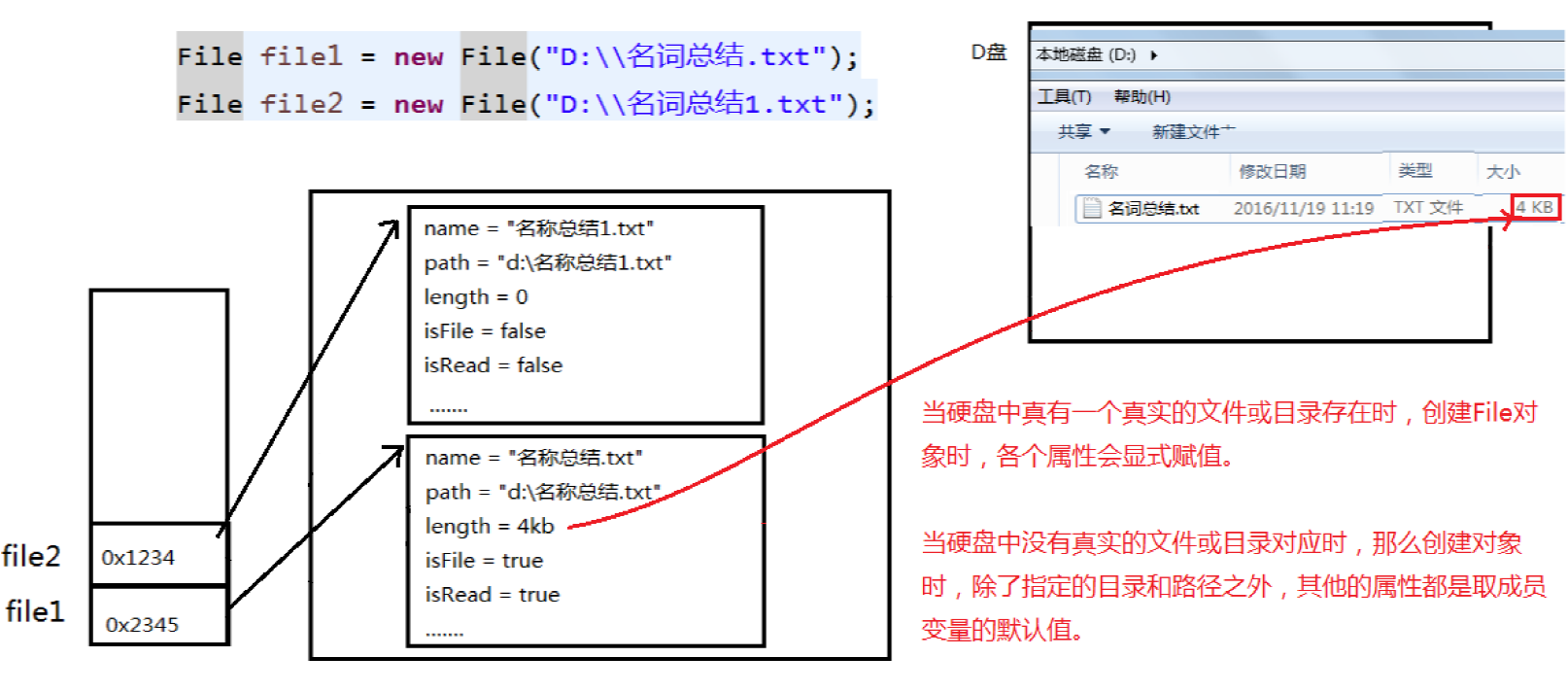
路径分隔符
路径中的每级目录之间用一个路径分隔符隔开。
路径分隔符和系统有关:
- windows和DOS系统默认使用“\”来表示
- UNIX和URL使用“/“来表示
Java程序支持跨平台运行,因此路径分隔符要慎用。
为了解决这个隐患,File类提供 了一个常量:
public static final String separator——根据操作系统,动态的提供分隔符。

常用方法
File类的获取功能
public String getAbsolutePath():获取绝对路径public String getPath():获取路径public String getName():获取名称public String getParent():获取上层文件目录路径。若无,返回nullpublic long length():获取文件长度(即:字节数)。不能获取目录的长度。public long lastModified():获取最后一次的修改时间,毫秒值
如下的两个方法适用于文件目录:
public String[] list():获取指定目录下的所有文件或者文件目录的名称数组public File[] listFiles():获取指定目录下的所有文件或者文件目录的File数组
@Test
public void test2(){
File file1 = new File("hello.txt");
File file2 = new File("d:\\io\\hi.txt");
System.out.println(file1.getAbsolutePath());
System.out.println(file1.getPath());
System.out.println(file1.getName());
System.out.println(file1.getParent());
System.out.println(file1.length());
System.out.println(new Date(file1.lastModified()));
System.out.println();
System.out.println(file2.getAbsolutePath());
System.out.println(file2.getPath());
System.out.println(file2.getName());
System.out.println(file2.getParent());
System.out.println(file2.length());
System.out.println(file2.lastModified());
}
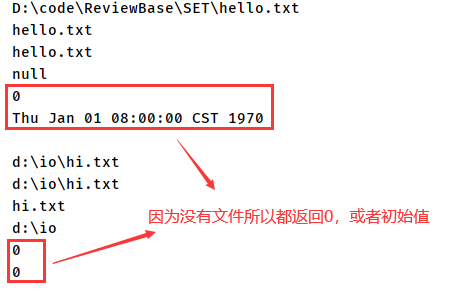
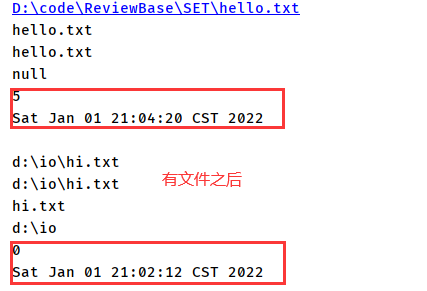
@Test
public void test3(){
File file = new File("d:\\io");
String[] list = file.list();
for(String s : list){
System.out.println(s);
}
System.out.println();
File[] files = file.listFiles();
for(File f : files){
System.out.println(f);
}
}

File类的重命名功能
public boolean renameTo(File dest):把文件重命名为指定的文件路径
- 比如:
file1.renameTo(file2)为例:要想保证返回true,需要file1在硬盘中是存在的,且file2不能在硬盘中存在。
@Test
public void test4(){
File file1 = new File("hello.txt");
File file2 = new File("D:\\IO\\hi.txt");
boolean renameTo = file1.renameTo(file2);
System.out.println(renameTo);
}
File类的判断功能
public boolean isDirectory():判断是否是文件目录
public boolean isFile() :判断是否是文件
public boolean exists() :判断是否存在
public boolean canRead() :判断是否可读
public boolean canWrite() :判断是否可写
public boolean isHidden() :判断是否隐藏
File类的创建功能
public boolean createNewFile() :创建文件。若文件存在,则不创建,返回false
public boolean mkdir() :创建文件目录。如果此文件目录存在,就不创建了。如果此文件目录的上层目录不存在,也不创建。
public boolean mkdirs():创建文件目录。如果此文件目录存在,就不创建了。如果上层文件目录不存在,一并创建
注意事项:如果你创建文件或者文件目录没有写盘符路径,那么,默认在项目路径下。
File类的删除功能
public boolean delete():删除文件或者文件夹
删除注意事项
- Java中的删除不走回收站
- 要删除一个文件目录,请注意该文件目录内不能包含文件或者文件目录
IO流原理及流的分类
Java IO原理
I/O是Input/Output的缩写,I/O技术是非常实用的技术,用于处理设备之间的数据传输。如读/写文件,网络通讯等。
Java程序中,对于数据的输入/输出操作以“流(stream)”的方式进行。
java.io包下提供了各种“流”类和接口,用以获取不同种类的数据,并通过标准的方法输入或输出数据。
输入与输出

输入input:读取外部数据(磁盘、光盘等存储设备的数据)到程序(内存)中。
输出output:将程序( 内存)数据输出到磁盘、光盘等存储设备中。
输入与输出都是站在程序的角度上看的
流的分类
按操作数据单位不同分为:字节流(8 bit), 字符流(16 bit)
按数据流的流向不同分为:输入流,输出流
按流的角色的不同分为:节点流,处理流
节点流:可以从或向一个特定的地方(节点)读写数据—>操作数据
处理流:是对一个已存在的流进行连接和封装,通过所封装的流的功能调用实现数据读写。—>处理流
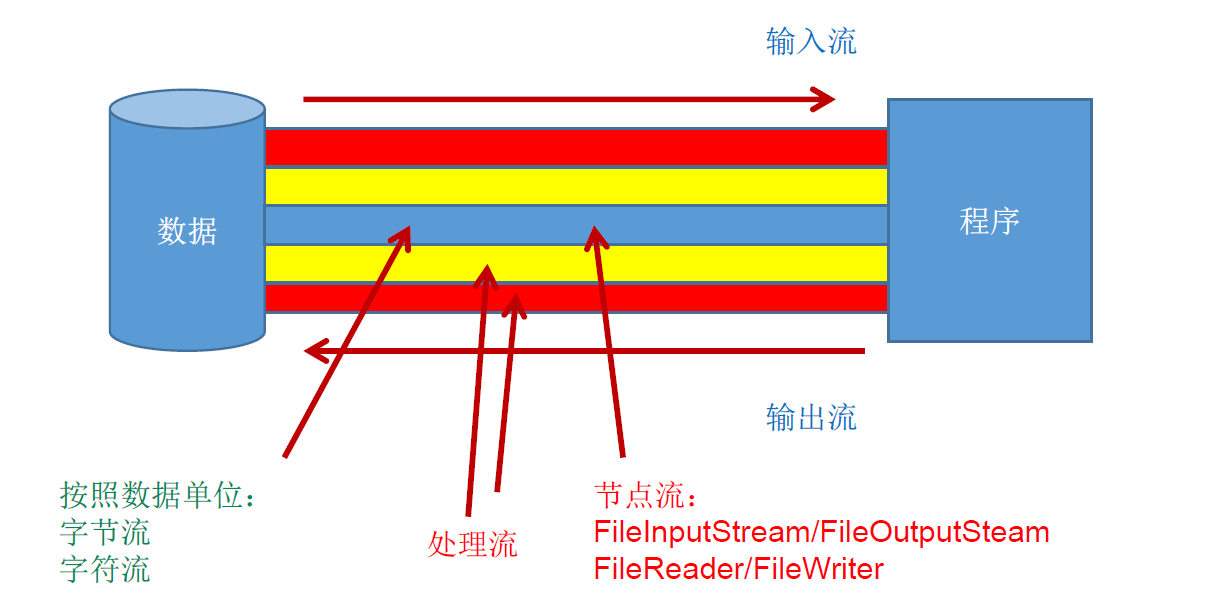
IO流体系
Java的IO流共涉及40多个类,实际上非常规则,都是从如下4个抽象基类派生的。

由这四个类派生出来的子类名称都是以其父类名作为子类名后缀。
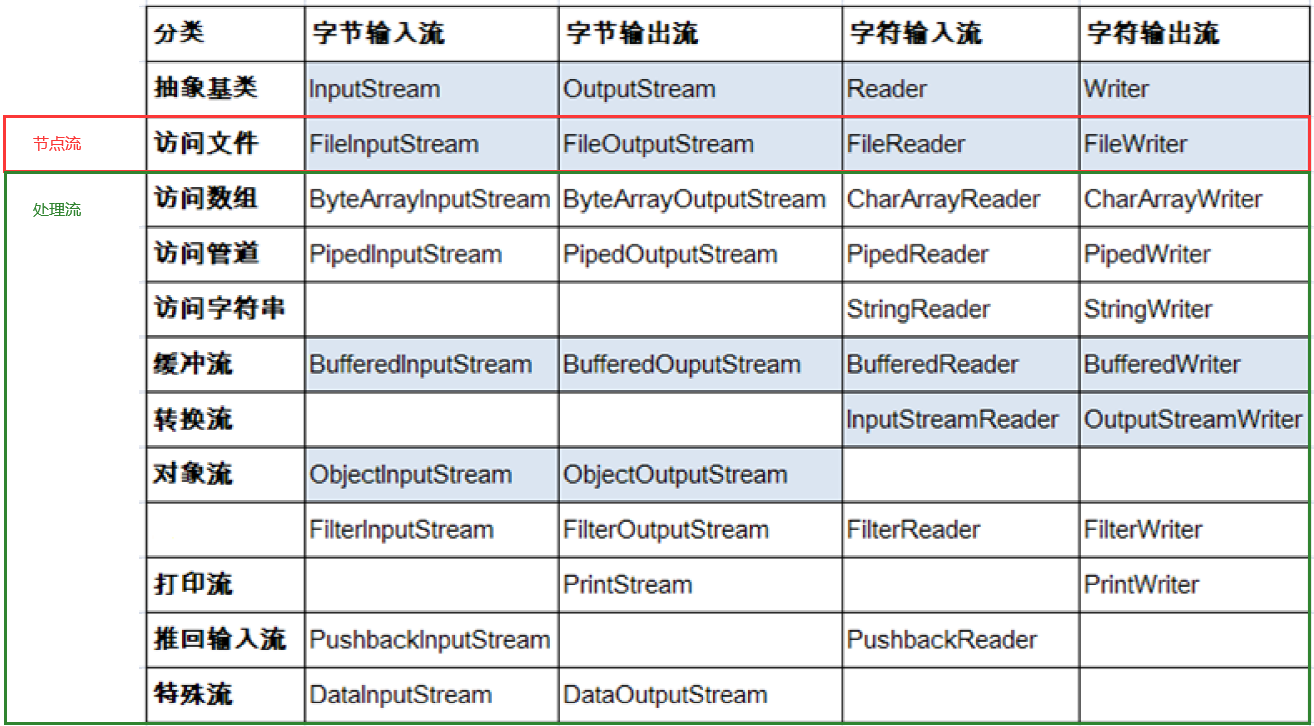
一些通用方法
InputStream
int read():从输入流中读取数据的下一个字节。返回0到255范围内的int字节值。如果因为已经到达流末尾而没有可用的字节,则返回值-1。
int read(byte[] b):从此输入流中将最多b.length个字节的数据读入一个byte 数组中。如果因为已经到达流末尾而没有可用的字节,则返回值-1。否则以整数形式返回实际读取的字节数。
int read(byte[] b, int off,int len):将输入流中最多len个数据字节读入byte 数组。尝试读取len个字节,但读取的字节也可能小于该值。以整数形式返回实际读取的字节数。如果因为流位于文件末尾而没有可用的字节,则返回值-1。
public void close() throws IOException:关闭此输入流并释放与该流关联的所有系统资源。
Reader
int read():读取单个字符。作为整数读取的字符,范围在0到65535之间(0x00-0ffff) (2 个字节的Unicode码),如果已到达流的末尾,则返回-1
int read(char[] cbuf):将字符读入数组。如果已到达流的末尾,则返回-1。否则返回本次读取的字符数。
int read(char[] cbuf,int off,int len):将字符读入数组的某一部分。存到数组cbuf中,从off处开始存储,最多读len个字符。如果已到达流的末尾,则返回-1。否则返回本次读取的字符数。
public void close() throws IOException:关闭此输入流并释放与该流关联的所有系统资源。
OutputStream
void write(int b):将指定的字节写入此输出流。write 的常规协定是:向输出流写入一个字节。要写入的字节是参数b的八个低位。b的24个高位将被忽略。即写 入0~255范围的。
void write(byte[] b):将b.length个字节从指定的byte数组写入此输出流。write(b) 的常规协定是:应该与调用write(b,0,b.length)的效果完全相同。
void write(byte[] b,int off,int len):将指定byte数组中从偏移量off开始的len个字节写入此输出流。
public void flush()throws IOException:刷新此输出流并强制写出所有缓冲的输出字节,调用此方法指示应将这些字节立即写入它们预期的目标。
public void close() throws IOException:关闭此输出流并释放与该流关联的所有系统资源。
Writer
void write(int c):写入单个字符。要写入的字符包含在给定整数值的16个低位中,16高位被忽略。即写入0到65535之间的Unicode码。
void write(char[] cbuf):写入字符数组。
void write(char[] cbuf,int off,int len):写入字符数组的某一部分。从off开始, 写入len个字符
void write(String str):写入字符串。
void write(String str,int off,int len):写入字符串的某一-部分。
void flush():刷新该流的缓冲,则立即将它们写入预期目标。
public void close() throws IOException:关闭此输出流并释放与该流关联的所有系统资源。
节点流(或文件流)
FileReader
@Test
public void testFileReader(){
FileReader fr = null;
try {
//1.实例化File类的对象,指明要操作的文件
File file = new File("hello.txt");//相较于当前Module
//2.提供具体的流
fr = new FileReader(file);
//3.数据的读入
//read():返回读入的一个字符。如果达到文件末尾,返回-1。
//方式一:
// int data = fr.read();
// while(data != -1){
// System.out.print((char)data);
// data = fr.read();
// }
//方式二:语法上针对于方式一的修改
int data;
while((data = fr.read()) != -1){
System.out.print((char)data);
}
} catch (IOException e) {
e.printStackTrace();
} finally {
//4.流的关闭操作
// try {
// if(fr != null)
// fr.close();
// } catch (IOException e) {
// e.printStackTrace();
// }
//或
if(fr != null){
try {
fr.close();
} catch (IOException e) {
e.printStackTrace();
}
}
}
}
@Test
public void testFileReader1() {
FileReader fr = null;
try {
//1.File类的实例化
File file = new File("hello.txt");
//2.FileReader流的实例化
fr = new FileReader(file);
//3.读入的操作
//read(char[] cbuf):返回每次读入cbuf数组中的字符的个数。如果达到文件末尾,返回-1
char[] cbuf = new char[5];
int len;
while((len = fr.read(cbuf)) != -1){
//方式一:
//错误的写法
// for(int i = 0;i < cbuf.length;i++){
// System.out.print(cbuf[i]);
// }
//正确的写法
// for(int i = 0;i < len;i++){
// System.out.print(cbuf[i]);
// }
//方式二:
//错误的写法,对应着方式一的错误的写法
// String str = new String(cbuf);
// System.out.print(str);
//正确的写法
String str = new String(cbuf,0,len);
System.out.print(str);
}
} catch (IOException e) {
e.printStackTrace();
} finally {
if(fr != null){
//4.资源的关闭
try {
fr.close();
} catch (IOException e) {
e.printStackTrace();
}
}
}
}
1-【为什么for(int i = 0;i < cbuf.length;i++)和String str = new String(cbuf)是错的写法】
1-假设**”hello.txt”**里面的内容为:helloworld123
2-那么我们在批量读取的时候是这么操作的:第一次读取5个字符 [h e l l o ],返回的len为5 —> 第二次读取5个字符 [w o r l d],替换char[]cbuf数组里面的5个字符,同时返回值为5 —>第三次只能读到3个字符[1 2 3],替换char[] cbuf数组里面的3个字符,最终的char[] cbuf数组为 [1 2 3 l d],同时值为3 —> 第四次读的时候已经没有字符了,返回值为-1
3-因此最终读取的内容为:helloworld123ld
2-read()的理解:返回读入的一个字符。如果达到文件末尾,返回-1
3-异常的处理:为了保证流资源一定可以执行关闭操作。需要使用try-catch-finally处理
4-读入的文件一定要存在,否则就会报FileNotFoundException。
FileWriter
@Test
public void testFileWriter() {
FileWriter fw = null;
try {
//1.提供File类的对象,指明写出到的文件
File file = new File("hello.txt");
//2.提供FileWriter的对象,用于数据的写出
fw = new FileWriter(file,true);
//3.写出的操作
fw.write("I have a dream!\n");
fw.write("you need to have a dream!");
} catch (IOException e) {
e.printStackTrace();
} finally {
//4.流资源的关闭
if(fw != null){
try {
fw.close();
} catch (IOException e) {
e.printStackTrace();
}
}
}
}
@Test
public void testFileReaderFileWriter() {
FileReader fr = null;
FileWriter fw = null;
try {
//1.创建File类的对象,指明读入和写出的文件
File srcFile = new File("hello.txt");
File destFile = new File("hello2.txt");
//不能使用字符流来处理图片等字节数据
// File srcFile = new File("爱情与友情.jpg");
// File destFile = new File("爱情与友情1.jpg");
//2.创建输入流和输出流的对象
fr = new FileReader(srcFile);
fw = new FileWriter(destFile);
//3.数据的读入和写出操作
char[] cbuf = new char[5];
int len;//记录每次读入到cbuf数组中的字符的个数
while((len = fr.read(cbuf)) != -1){
//每次写出len个字符
fw.write(cbuf,0,len);
}
} catch (IOException e) {
e.printStackTrace();
} finally {
//4.关闭流资源
try {
if(fw != null)
fw.close();
} catch (IOException e) {
e.printStackTrace();
}
try {
if(fr != null)
fr.close();
} catch (IOException e) {
e.printStackTrace();
}
}
}
1-输出操作,对应的File可以不存在的。并不会报异常
2-File对应的硬盘中的文件如果不存在,在输出的过程中,会自动创建此文件。
3-File对应的硬盘中的文件如果存在:
- 3-1-如果流使用的构造器是:
FileWriter(file,false)/FileWriter(file):对原有文件的覆盖 - 3-2-如果流使用的构造器是:
FileWriter(file,true):不会对原有文件覆盖,而是在原有文件基础上追加内容
FileInputStream和FileOutputStream
//使用字节流FileInputStream处理文本文件,可能出现乱码。
@Test
public void testFileInputStream() {
FileInputStream fis = null;
try {
//1. 造文件
File file = new File("hello.txt");
//2.造流
fis = new FileInputStream(file);
//3.读数据
byte[] buffer = new byte[5];
int len;//记录每次读取的字节的个数
while((len = fis.read(buffer)) != -1){
String str = new String(buffer,0,len);
System.out.print(str);
}
} catch (IOException e) {
e.printStackTrace();
} finally {
if(fis != null){
//4.关闭资源
try {
fis.close();
} catch (IOException e) {
e.printStackTrace();
}
}
}
}
为什么使用字节流处理文本文件会出现乱码?
1-因为字节流传送数据用的是byte[]buffer,是字节数组。对于英文字母来说,都是一个字母占一个字节,所以其实输入输出都没问题
2-但是对于中文字符,在UTF-8 编码中一个中文字符占3个字节,在Unicode 编码中一个中文字符占两个字节
3-我们是每运5个字节处理一次(比如打印),这样就会乱码
/*
实现对图片的复制操作
*/
@Test
public void testFileInputOutputStream() {
FileInputStream fis = null;
FileOutputStream fos = null;
try {
//
File srcFile = new File("爱情与友情.jpg");
File destFile = new File("爱情与友情1.jpg");
//
fis = new FileInputStream(srcFile);
fos = new FileOutputStream(destFile);
//复制的过程
byte[] buffer = new byte[5];
int len;
while((len = fis.read(buffer)) != -1){
fos.write(buffer,0,len);
}
} catch (IOException e) {
e.printStackTrace();
} finally {
if(fos != null){
//
try {
fos.close();
} catch (IOException e) {
e.printStackTrace();
}
}
if(fis != null){
try {
fis.close();
} catch (IOException e) {
e.printStackTrace();
}
}
}
}
//指定路径下文件的复制
public void copyFile(String srcPath,String destPath){
FileInputStream fis = null;
FileOutputStream fos = null;
try {
File srcFile = new File(srcPath);
File destFile = new File(destPath);
fis = new FileInputStream(srcFile);
fos = new FileOutputStream(destFile);
//复制的过程
byte[] buffer = new byte[1024];
int len;
while((len = fis.read(buffer)) != -1){
fos.write(buffer,0,len);
}
} catch (IOException e) {
e.printStackTrace();
} finally {
if(fos != null){
//
try {
fos.close();
} catch (IOException e) {
e.printStackTrace();
}
}
if(fis != null){
try {
fis.close();
} catch (IOException e) {
e.printStackTrace();
}
}
}
}
@Test
public void testCopyFile(){
long start = System.currentTimeMillis();
String srcPath = "C:\\Users\\Administrator\\Desktop\\01-视频.avi";
String destPath = "C:\\Users\\Administrator\\Desktop\\02-视频.avi";
// String srcPath = "hello.txt";
// String destPath = "hello3.txt";
copyFile(srcPath,destPath);
long end = System.currentTimeMillis();
System.out.println("复制操作花费的时间为:" + (end - start));//618
}
为什么我们使用字节流复制文本文件就不会出问题呢?:因为我们没有处理字节,只是5个一次搬运字节,最后打开,所以最后不会出现乱码
对于文本文件(.txt,.java,.c,.cpp),使用字符流处理
对于非文本文件(.jpg,.mp3,.mp4,.avi,.doc,.ppt,…),使用字节流处理
缓冲流
BufferedInputStream和BufferedOutputStream
@Test
public void BufferedStreamTest() throws FileNotFoundException {
BufferedInputStream bis = null;
BufferedOutputStream bos = null;
try {
//1.造文件
File srcFile = new File("爱情与友情.jpg");
File destFile = new File("爱情与友情3.jpg");
//2.造流
//2.1 造节点流
FileInputStream fis = new FileInputStream((srcFile));
FileOutputStream fos = new FileOutputStream(destFile);
//2.2 造缓冲流 ———— 处理流
bis = new BufferedInputStream(fis);
bos = new BufferedOutputStream(fos);
//3.复制的细节:读取、写入
byte[] buffer = new byte[10];
int len;
while((len = bis.read(buffer)) != -1){
bos.write(buffer,0,len);
// bos.flush();//刷新缓冲区
}
} catch (IOException e) {
e.printStackTrace();
} finally {
//4.资源关闭
//要求:先关闭外层的流,再关闭内层的流
if(bos != null){
try {
bos.close();
} catch (IOException e) {
e.printStackTrace();
}
}
if(bis != null){
try {
bis.close();
} catch (IOException e) {
e.printStackTrace();
}
}
//说明:关闭外层流的同时,内层流也会自动的进行关闭。关于内层流的关闭,我们可以省略.
// fos.close();
// fis.close();
}
}
//实现文件复制的方法
public void copyFileWithBuffered(String srcPath,String destPath){
BufferedInputStream bis = null;
BufferedOutputStream bos = null;
try {
//1.造文件
File srcFile = new File(srcPath);
File destFile = new File(destPath);
//2.造流
//2.1 造节点流
FileInputStream fis = new FileInputStream((srcFile));
FileOutputStream fos = new FileOutputStream(destFile);
//2.2 造缓冲流
bis = new BufferedInputStream(fis);
bos = new BufferedOutputStream(fos);
//3.复制的细节:读取、写入
byte[] buffer = new byte[1024];
int len;
while((len = bis.read(buffer)) != -1){
bos.write(buffer,0,len);
}
} catch (IOException e) {
e.printStackTrace();
} finally {
//4.资源关闭
//要求:先关闭外层的流,再关闭内层的流
if(bos != null){
try {
bos.close();
} catch (IOException e) {
e.printStackTrace();
}
}
if(bis != null){
try {
bis.close();
} catch (IOException e) {
e.printStackTrace();
}
}
//说明:关闭外层流的同时,内层流也会自动的进行关闭。关于内层流的关闭,我们可以省略.
// fos.close();
// fis.close();
}
}
@Test
public void testCopyFileWithBuffered(){
long start = System.currentTimeMillis();
String srcPath = "C:\\Users\\Administrator\\Desktop\\01-视频.avi";
String destPath = "C:\\Users\\Administrator\\Desktop\\03-视频.avi";
copyFileWithBuffered(srcPath,destPath);
long end = System.currentTimeMillis();
System.out.println("复制操作花费的时间为:" + (end - start));//618 - 176
}
BufferedReader和BufferedWriter
@Test
public void testBufferedReaderBufferedWriter(){
BufferedReader br = null;
BufferedWriter bw = null;
try {
//创建文件和相应的流
br = new BufferedReader(new FileReader(new File("dbcp.txt")));
bw = new BufferedWriter(new FileWriter(new File("dbcp1.txt")));
//读写操作
//方式一:使用char[]数组
// char[] cbuf = new char[1024];
// int len;
// while((len = br.read(cbuf)) != -1){
// bw.write(cbuf,0,len);
// // bw.flush();
// }
//方式二:使用String
String data;
while((data = br.readLine()) != null){
//方法一:
// bw.write(data + "\n");//data中不包含换行符
//方法二:
bw.write(data);//data中不包含换行符
bw.newLine();//提供换行的操作
}
} catch (IOException e) {
e.printStackTrace();
} finally {
//关闭资源
if(bw != null){
try {
bw.close();
} catch (IOException e) {
e.printStackTrace();
}
}
if(br != null){
try {
br.close();
} catch (IOException e) {
e.printStackTrace();
}
}
}
}
缓存流的作用:提高读写速度——原因:内部提供了一个缓冲区
BufferedInputStream和BufferedOutputStream的源码片段:
private static int DEFAULT_BUFFER_SIZE = 8192;
public BufferedInputStream(InputStream in) {
this(in, DEFAULT_BUFFER_SIZE);
}
public BufferedInputStream(InputStream in, int size) {
super(in);
if (size <= 0) {
throw new IllegalArgumentException("Buffer size <= 0");
}
buf = new byte[size];
}
BufferedReader和BufferedWriter的源码片段:
private static int defaultCharBufferSize = 8192;
public BufferedReader(Reader in) {
this(in, defaultCharBufferSize);
}
public BufferedReader(Reader in, int sz) {
super(in);
if (sz <= 0)
throw new IllegalArgumentException("Buffer size <= 0");
this.in = in;
cb = new char[sz];
nextChar = nChars = 0;
}
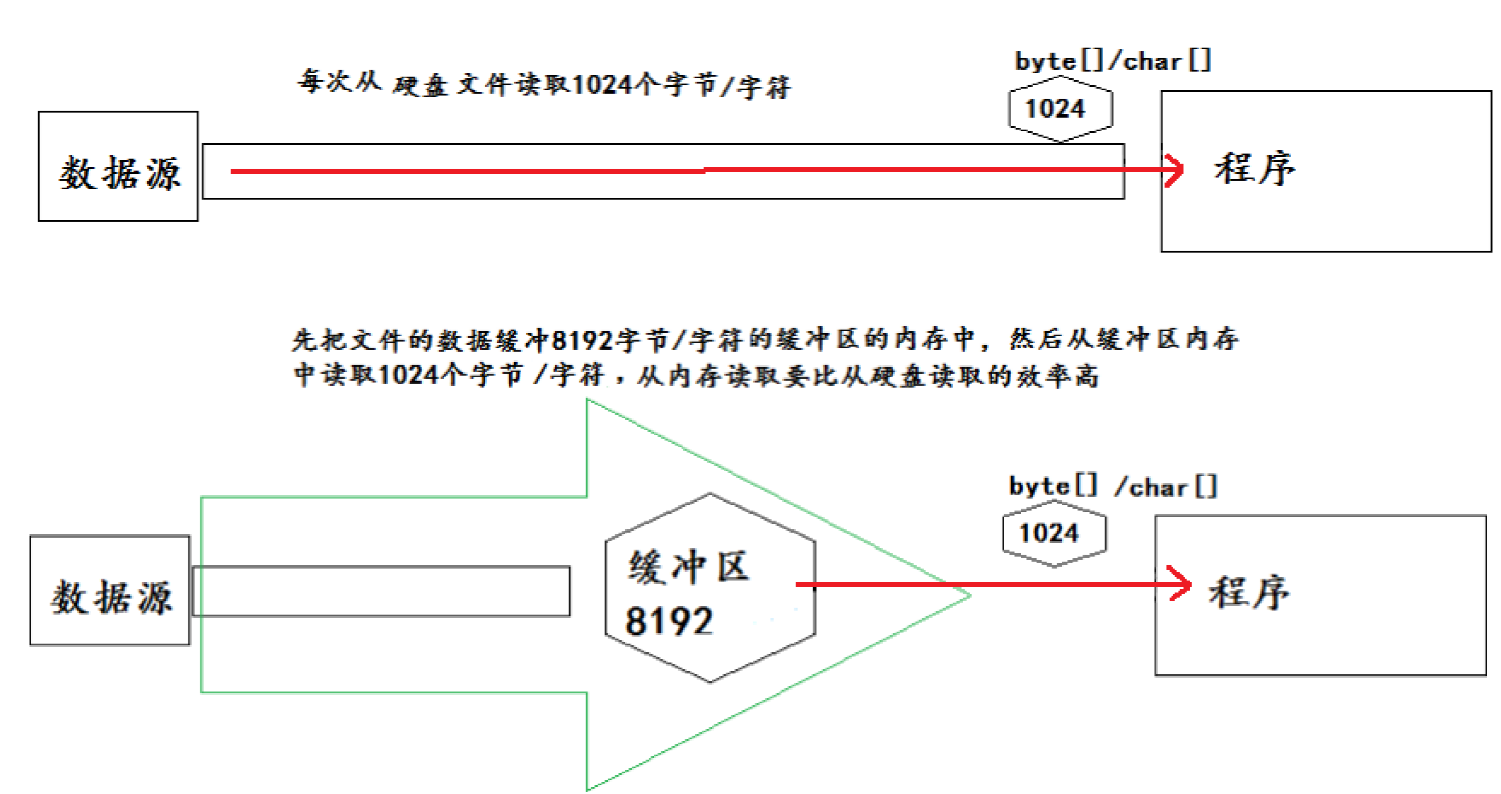
1-当读取数据时,数据按块读入缓冲区,其后的读操作则直接访问缓冲区
2-当使用BufferedInputStream读取字节文件时,BufferedInputStream会 一次性从文件中读取8192个(8Kb),存在缓冲区中,直到缓冲区装满了,才重新从文件中读取下一个8192个字节数组。
3-向流中写入字节时,不会直接写到文件,先写到缓冲区中直到缓冲区写满,BufferedOutputStream才会把缓冲区中的数据一次性写到文件里。使用方法flush()可以强制将缓冲区的内容全部写入输出流。
4-关闭流的顺序和打开流的顺序相反。只要关闭最外层流即可,关闭最外层流也会相应关闭内层节点流
5-flush()方法的使用:手动将buffer中内容写入文件
6-如果是带缓冲区的流对象的close()方法,不但会关闭流,还会在关闭流之前刷新缓冲区,关闭后不能再写出。
转换流
InputStreamReader与OutputStreamWriter:字符流
@Test
public void test1() throws IOException {
FileInputStream fis = new FileInputStream("dbcp.txt");
//InputStreamReader isr = new InputStreamReader(fis);//使用系统默认的字符集
//参数2指明了字符集,具体使用哪个字符集,取决于文件dbcp.txt保存时使用的字符集
InputStreamReader isr =
new InputStreamReader(fis,"UTF-8");//使用系统(idea)默认的字符集
char[] cbuf = new char[20];
int len;
while((len = isr.read(cbuf)) != -1){
String str = new String(cbuf,0,len);
System.out.print(str);//结果是没有出现乱码
}
isr.close();
}
使用FileInputStream读取文本文件 —> 在字节流的基础上使用InputStreamReader转换成字符流 —>使用字符流处理文件(打印文件内容到控制台)
@Test
public void test2() throws Exception {
//1.造文件、造流
File file1 = new File("dbcp.txt");
File file2 = new File("dbcp_gbk.txt");
FileInputStream fis = new FileInputStream(file1);
FileOutputStream fos = new FileOutputStream(file2);
InputStreamReader isr = new InputStreamReader(fis,"utf-8");
OutputStreamWriter osw = new OutputStreamWriter(fos,"gbk");
//2.读写过程
char[] cbuf = new char[20];
int len;
while((len = isr.read(cbuf)) != -1){
osw.write(cbuf,0,len);
}
//3.关闭资源
isr.close();
osw.close();
}
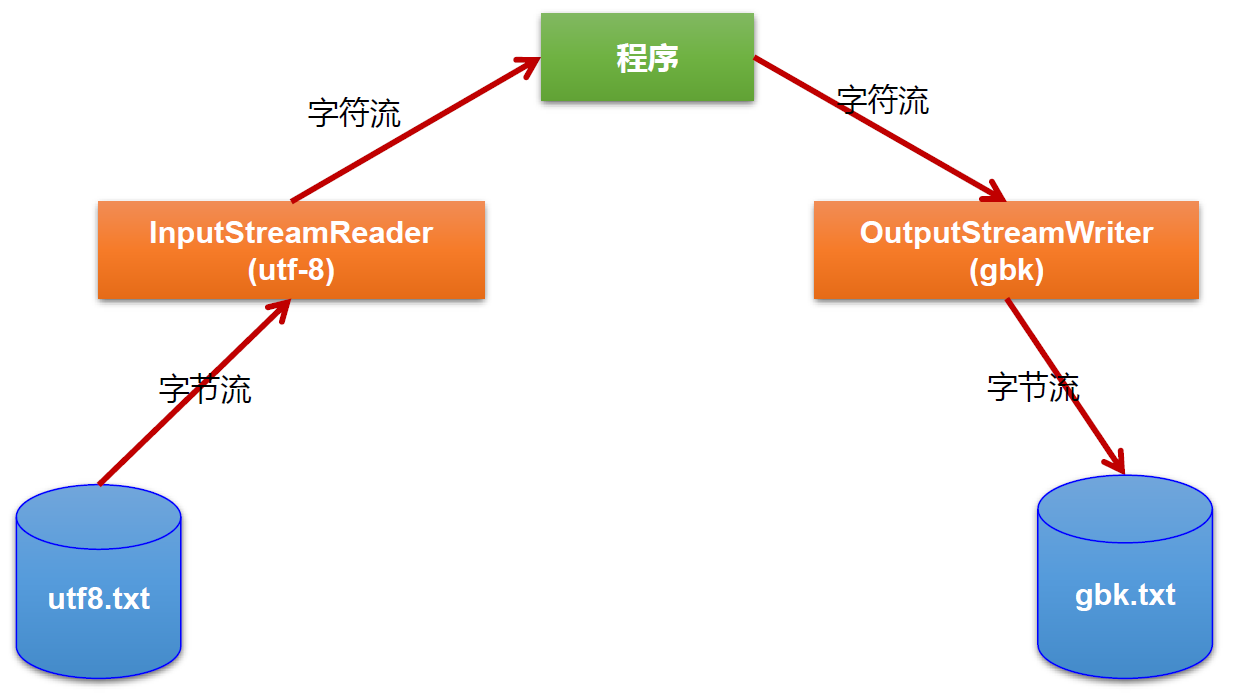
字符编码
编码表的由来
计算机只能识别二进制数据,早期由来是电信号。为了方便应用计算机,让它可以识别各个国家的文字。就将各个国家的文字用数字来表示,并一一对应,形成一张表。这就是编码表。
常见的编码表.
ASCII:美国标准信息交换码。用一个字节的7位可以表示。
IS08859-1: 拉丁码表。欧洲码表。用一个字节的8位表示。
GB2312:中国的中文编码表。最多两个字节编码所有字符。
GBK:中国的中文编码表升级,融合了更多的中文文字符号。最多两个字节编码
Unicode:国际标准码,融合了目前人类使用的所有字符。为每个字符分配唯一的字符码。所有的文字都用两个字节来表示。
UTF-8:变长的编码方式,可用1-4个字节来表示一个字符。
Unicode的问题
Unicode不完美,这里就有三个问题:
- 一个是,我们已经知道,英文字母只用一个字节表示就够了,
- 第二个问题是如何才能区别Unicode和ASCII?计算机怎么知道两个字节表示一个符号,而不是分别表示两个符号呢?
- 第三个,如果和GBK等双字节编码方式一样,用最高位是1或0表示两个字节和一个字节,就少了很多值无法用于表示字符,不够表示所有字符。
Unicode在很 长一段时间内无法推广,直到互联网的出现。
UTF
面向传输的众多 UTF ( UCS Transfer Format)标准出现了,顾名思义,UTF-8就是每次8个位传输数据,而UTF-16就是每次16个位。这是为传输而设计的编码,并使编码无国界,这样就可以显示全世界上所有文化的字符了。
字符集与编码
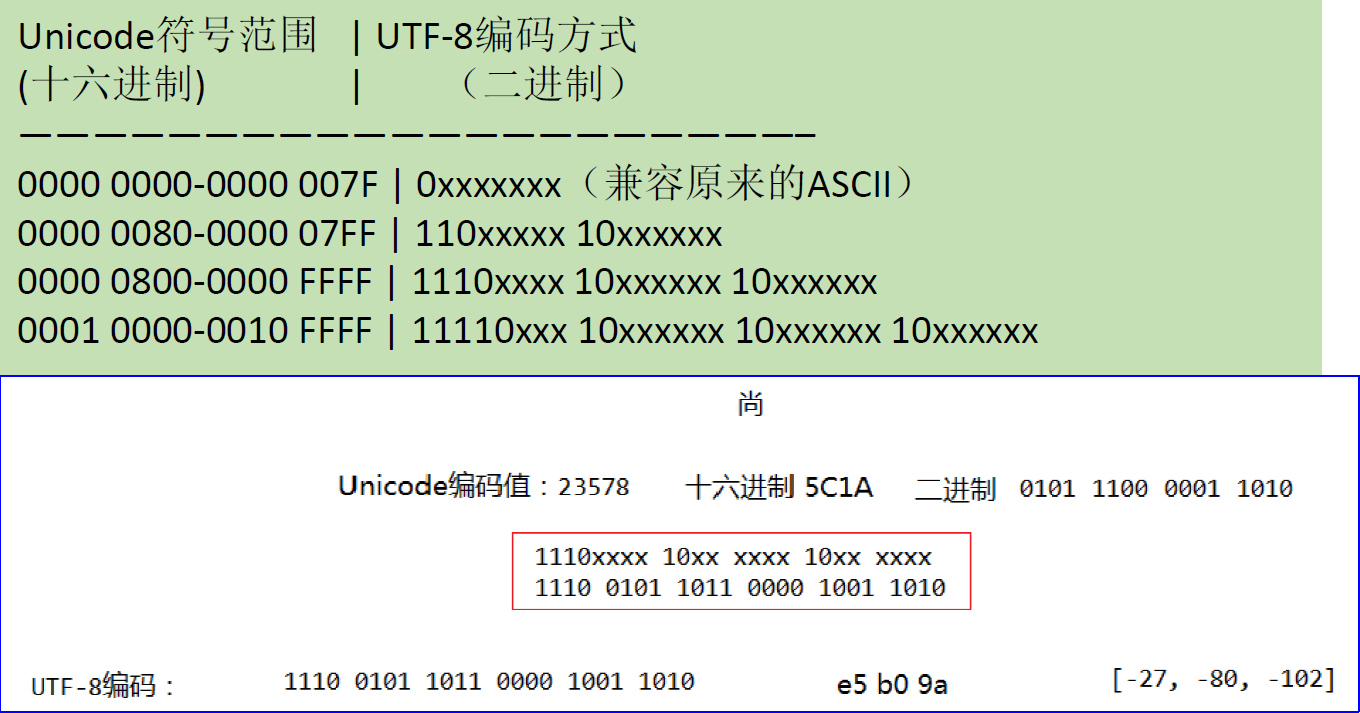

标准输入、输出流(了解)
System.in和System.out分别代表了系统标准的输入和输出设备
默认输入设备是:键盘,输出设备是:显示器
System.in的类型是InputStream:
public final static InputStream in = null;public final static InputStream in = null;
public final static PrintStream out = null;
System类的setIn(InputStream is) / setOut(PrintStream ps)方式重新指定输入和输出的流。
public static void setln(InputStream in)public static void setOut(PrintStream out)
/**练习:
从键盘输入字符串,要求将读取到的整行字符串转成大写输出。然后继续进行输入操作,
直至当输入“e”或者“exit”时,退出程序。
方法一:使用Scanner实现,调用next()返回一个字符串
方法二:使用System.in实现。System.in ---> 转换流 ---> BufferedReader的readLine()*/
public static void main(String[] args) {
BufferedReader br = null;
try {
//从字节流转换为字符类
InputStreamReader isr = new InputStreamReader(System.in);
//缓存流包装字符流
br = new BufferedReader(isr);
while (true) {
System.out.println("请输入字符串:");
String data = br.readLine();
if ("e".equalsIgnoreCase(data) || "exit".equalsIgnoreCase(data)) {
System.out.println("程序结束");
break;
}
String upperCase = data.toUpperCase();
System.out.println(upperCase);
}
} catch (IOException e) {
e.printStackTrace();
} finally {
if (br != null) {
try {
br.close();
} catch (IOException e) {
e.printStackTrace();
}
}
}
}
打印流(了解)
实现将基本数据类型的数据格式转化为字符串输出
打印流:PrintStream和PrintWriter —>打印到文件上
- 提供了一系列重载的
print()和println()方法,用于多种数据类型的输出 - PrintStream和PrintWriter的输出不会抛出lOException异常
- PrintStream和PrintWriter有自动flush功能
- PrintStream打印的所有字符都使用平台的默认字符编码转换为字节。
- 在需要写入字符而不是写入字节的情况下,应该使用PrintWriter 类。
//报ASCII字符输出到 "D:\\IO\\text.txt" 里面
@Test
public void test2() {
PrintStream ps = null;
try {
FileOutputStream fos = new FileOutputStream(new File("D:\\IO\\text.txt"));
// 创建打印输出流,设置为自动刷新模式(写入换行符或字节 '\n' 时都会刷新输出缓冲区)
ps = new PrintStream(fos, true);
if (ps != null) {// 把标准输出流(控制台输出)改成文件(打印输出流)
System.setOut(ps);
}
for (int i = 0; i <= 255; i++) { // 输出ASCII字符
System.out.print((char) i);
if (i % 50 == 0) { // 每50个数据一行
System.out.println(); // 换行
}
}
} catch (FileNotFoundException e) {
e.printStackTrace();
} finally {
if (ps != null) {
ps.close();
}
}
}
数据流(了解)
为了方便地操作Java语言的基本数据类型和String的数据,可以使用数据流。
数据流有两个类: (用于读取和写出基本数据类型、String类的数据)
- DatalnputStream和DataOutputStream
- 分别“套接”在InputStream和OutputStream子类的流上
DatalnputStream中的方法
- boolean readBoolean()
- byte readByte()
- char readChar()
- float readFloat( )
- double readDouble()
- short readShort( )
- long readL ong()
- int readInt()
- String readUTF()
- void readFully(byte[] b)
DataOutputStream中的方法:将上述的方法的read改为相应的write即可。
//将内存中的字符串、基本数据类型的变量写出到文件中。
@Test
public void test3() throws IOException {
DataOutputStream dos =
new DataOutputStream(new FileOutputStream("data.txt"));
dos.writeUTF("刘亦菲");
dos.flush();//刷新操作,将内存中的数据写入文件
dos.writeInt(35);
dos.flush();
dos.writeBoolean(true);
dos.flush();
dos.close();
}
//将文件中存储的基本数据类型变量和字符串读取到内存中,保存在变量中。
@Test
public void test4() throws IOException {
DataInputStream dis =
new DataInputStream(new FileInputStream("data.txt"));
String name = dis.readUTF();
int age = dis.readInt();
boolean isMale = dis.readBoolean();
System.out.println("name = " + name);
System.out.println("age = " + age);
System.out.println("isMale = " + isMale);
dis.close();
}
对象流
**ObjectInputStream和OjbectOutputSteam:**用于存储和读取基本数据类型数据或对象的处理流。它的强大之处就是可以把Java中的对象写入到数据源中,也能把对象从数据源中还原回来。
对象的序列化
序列化与反序列化
- 序列化:将内存中的java对象保存到磁盘中或通过网络传输出去
- 反序列化:将磁盘文件中的对象还原为内存中的一个java对象
对象序列化机制:
- 允许把内存中的Java对象转换成平台无关的二进制流,从而允许把这种二进制流持久地保存在磁盘上,或通过网络将这种二进制流传输到另一个网络节点。当其它程序获取了这种二进制流,就可以恢复成原来的Java对象(反序列化)
序列化的好处在于可将任何实现了Serializable接口的对象转化为字节数据,使其在保存和传输时可被还原
序列化是RMI(Remote Method Invoke-远程方法调用)过程的参数和返回值都必须实现的机制,而RMI是JavaEE的基础。因此序列化机制是JavaEE平台的基础
如果需要让某个对象支持序列化机制,则必须让对象所属的类及其属性是可序列化的,为了让某个类是可序列化的,该类必须实现如下两个接口之一。否则,会抛出NotSerializableException异常
- Serializable
- Externalizable
ObjectOutputStream和ObjectInputStream不能序列化static和transient修饰的成员变量。
一个类需要满足如下的要求,方可序列化
- 需要实现接口:Serializable
- 当前类提供一个全局常量:serialVersionUID
- 除了当前Person类需要实现Serializable接口之外,还必须保证其内部所有属性也必须是可序列化的。(默认情况下,基本数据类型可序列化)
public class Person implements Serializable{ // 需要实现接口:Serializable
public static final long serialVersionUID = 475463534532L; // 当前类提供一个全局常量:serialVersionUID
private String name;
private int age;
private int id;
private Account acct; // Account也支持序列化
public Person(String name, int age, int id) {
this.name = name;
this.age = age;
this.id = id;
}
public Person(String name, int age, int id, Account acct) {
this.name = name;
this.age = age;
this.id = id;
this.acct = acct;
}
@Override
public String toString() {
return "Person{" +
"name='" + name + '\'' +
", age=" + age +
", id=" + id +
", acct=" + acct +
'}';
}
public int getId() {
return id;
}
public void setId(int id) {
this.id = id;
}
public String getName() {
return name;
}
public void setName(String name) {
this.name = name;
}
public int getAge() {
return age;
}
public void setAge(int age) {
this.age = age;
}
public Person(String name, int age) {
this.name = name;
this.age = age;
}
public Person() {
}
}
class Account implements Serializable{ // Account也支持序列化
public static final long serialVersionUID = 4754534532L;
private double balance;
@Override
public String toString() {
return "Account{" +
"balance=" + balance +
'}';
}
public double getBalance() {
return balance;
}
public void setBalance(double balance) {
this.balance = balance;
}
public Account(double balance) {
this.balance = balance;
}
}
/*
序列化过程:将内存中的java对象保存到磁盘中或通过网络传输出去
使用ObjectOutputStream实现
*/
@Test
public void testObjectOutputStream(){
ObjectOutputStream oos = null;
try {
//1.
oos = new ObjectOutputStream(new FileOutputStream("object.dat"));
//2.
oos.writeObject(new String("我爱北京天安门"));
oos.flush();//刷新操作
oos.writeObject(new Person("王铭",23));
oos.flush();
oos.writeObject(new Person("张学良",23,1001,new Account(5000)));
oos.flush();
} catch (IOException e) {
e.printStackTrace();
} finally {
if(oos != null){
//3.
try {
oos.close();
} catch (IOException e) {
e.printStackTrace();
}
}
}
}
/*
反序列化:将磁盘文件中的对象还原为内存中的一个java对象
使用ObjectInputStream来实现
*/
@Test
public void testObjectInputStream(){
ObjectInputStream ois = null;
try {
ois = new ObjectInputStream(new FileInputStream("object.dat"));
Object obj = ois.readObject();
String str = (String) obj;
Person p = (Person) ois.readObject();
Person p1 = (Person) ois.readObject();
System.out.println(str);
System.out.println(p);
System.out.println(p1);
} catch (IOException e) {
e.printStackTrace();
} catch (ClassNotFoundException e) {
e.printStackTrace();
} finally {
if(ois != null){
try {
ois.close();
} catch (IOException e) {
e.printStackTrace();
}
}
}
}
serialVersionUID的作用:
serialVersionUID用来表明类的不同版本间的兼容性。简言之,其目的是以序列化对象进行版本控制,有关各版本反序列化时是否兼容。
就是如果我们没有显示声明这个常量,时当我们序列化的时候,其实
jvm会根据类的内容自动分配一个ID,如果该类的代码没变,依然可以正常反序列化。但是如果这个类的代码变了,JVM会根据内容又生成一个ID,然后序列化时候的ID和反序列化时候的ID不一致,就无法反序列化
随机存取文件流:RandomAccessFile类
RandomAccessFile声明在java.io包下,但直接继承于java.lang.Object类。并且它实现了Datalnput、DataOutput这两个接口,也就意味着这个类既可以读也可以写。
RandomAccessFile类支持“随机访问”的方式,程序可以直接跳到文件的任意地方来读、写文件
RandomAccessFile对象包含-一个记录指针,用以标示当前读写处的位置。
RandomAccessFile类对象可以自由移动记录指针:
long getFilePointer():获取文件记录指针的当前位置void seek(long pos):将文件记录指针定位到pos位置
构造器
public RandomAccessFile(File file, String mode)public RandomAccessFile(String name, String mode)
创建RandomAccessFile类实例需要指定一个mode参数,该参数指定RandomAccessFile的访问模式:
- r:以只读方式打开
- rw:打开以便读取和写入
- rwd:打开以便读取和写入;同步文件内容的更新
- rws:打开以便读取和写入;同步文件内容和元数据的更新
@Test
public void test1() {
RandomAccessFile raf1 = null;
RandomAccessFile raf2 = null;
try {
//1.
raf1 = new RandomAccessFile(
new File("爱情与友情.jpg"),"r");
raf2 = new RandomAccessFile(
new File("爱情与友情3.jpg"),"rw");
//2.
byte[] buffer = new byte[1024];
int len;
while((len = raf1.read(buffer)) != -1){
raf2.write(buffer,0,len);
}
} catch (IOException e) {
e.printStackTrace();
} finally {
//3.
if(raf1 != null){
try {
raf1.close();
} catch (IOException e) {
e.printStackTrace();
}
}
if(raf2 != null){
try {
raf2.close();
} catch (IOException e) {
e.printStackTrace();
}
}
}
}
@Test
public void test2() throws IOException {
RandomAccessFile raf1 =
new RandomAccessFile("hello.txt","rw");
raf1.seek(3);//将指针调到角标为3的位置
raf1.write("xyz".getBytes());//
raf1.close();
}
@Test
public void test3() throws IOException {
RandomAccessFile raf1 =
new RandomAccessFile("hello.txt","rw");
raf1.seek(3);//将指针调到角标为3的位置
//保存指针3后面的所有数据存到StringBuilder中
StringBuilder builder =
new StringBuilder(
(int) new File("hello.txt")
.length());
byte[] buffer = new byte[20];
int len;
while((len = raf1.read(buffer)) != -1){
builder.append(new String(buffer,0,len)) ;
}
//调回指针,写入“xyz”
raf1.seek(3);
raf1.write("xyz".getBytes());
//将StringBuilder中的数据写入到文件中
raf1.write(builder.toString().getBytes());
raf1.close();
//思考:将StringBuilder替换为ByteArrayOutputStream
}
以插入为例,说一说指针的运动
raf1.seek(3):把指针调到角标为3的位置
raf1.read(buffer)):读取文件的时候指针会接着往后运动,到读完文件的时候,指针回到最后,或者是第一
raf1.seek(3):在把指针调回角标为3的位置
我们可以用RandomAccessFile这个类,来实现一个多线程断点下载的功能,用过下载工具的朋友们都知道,下载前都会建立两个临时文件,一个是与被下载文件大小相同的空文件,另一个是记录文件指针的位置文件,每次暂停的时候,都会保存上一次的指针,然后断点下载的时候,会继续从上一次的地方下载,从而实现断点下载或上传的功能,有兴趣的朋友们可以自己实现下。
NIO.2中Path、Paths、 Files类的使用
Java NIO (New IO,Non-Blocking IO)是从Java 1.4版本开始引入的一套新的IO API, 可以替代标准的Java IO API。NIO与原来的IO有同样的作用和目的,但是使用的方式完全不同,NIO支持面向缓冲区的(IO是面向流的)、基于通道的IO操作。NIO将以更加高效的方式进行文件的读写操作。
JavaAPI中提供了两套NIO,一套是针对标准输入输出NIO,另一套就是网络编程NIO。

随着JDK 7的发布,Java对NIO进行了极大的扩展,增强了对文件处理和文件系统特性的支持,以至于我们称他们为NIO.2。因为NIO提供的一些功能,NIO已经成为文件处理中越来越重要的部分。
早期的Java只提供了一个File类来访问文件系统,但File类的功能比较有限,所提供的方法性能也不高。而且,大多数方法在出错时仅返回失败,并不会提供异常信息。
NIO.2为了弥补这种不足,引入了Path接口,代表一个平台无关的平台路径,描述了目录结构中文件的位置。Path可以看成是File类的升级版本,实际引用的资源也可以不存在。
在以前IO操作都是这样写的:
import java.io.File;
File file = new File("index.html");
但在Java7中,我们可以这样写:
import java.nio.file. Path;
import java.nio.file. Paths;
Path path = Paths.get("index.html");
同时,NIO.2在java.nio.file包 下还提供了Files、Paths工具类,Files包含了大量静态的工具方法来操作文件; Paths类提供的静态get()方法用来获取Path对象
static Path get(String first, String ... more):用于将多个字符串串连成路径static Path get(URI uri):返回指定uri对应的Path路径
Path常用方法:
String toString():返回调用Path对象的字符串表示形式boolean startsWith(String path):判断是否以path路径开始boolean endsWith(String path):判断是否以path路径结束boolean isAbsolute():判断是否是绝对路径Path getParent():返回Path对象包含整个路径,不包含Path对象指定的文件路径PathgetRoot():返回调用Path对象的根路径Path getFileName():返回与调用Path对象关联的文件名int getNameCount():返回Path根目录后面元素的数量Path getName(int idx):返回指定索引位置 idx的路径名称Path toAbsolutePath(): 作为绝对 路径返回调用Path对象Pathresolve(Pathp):合并两个路径,返回合并后的路径对应的Path对象File toFile():将Path转化为File类的对象
Files常用方法:
Path copy(Path src, Path dest, CopyOption ... how):文件的复制Path createDirectory(Path path, FileAttribute<?> ... attr):创建-一个目录Path createFile(Path path, FileAttribute<?> ... arr):创建一个文件void delete(Path path):删除一一个 文件/目录,如果不存在,执行报错void deletelfExists(Path path): Path对应的文件/目录如果存在,执行删除Path move(Path src, Path dest, CopyOption...how):将src移动到dest位置long size(Path path):返回path指定文件的大小boolean exists(Path path, LinkOption ... opts):判断文件是否存在boolean isDirectory(Path path, LinkOption ... opts):判断是否是目录boolean isRegularFile(Path path, LinkOption ... opts):判断是否是文件boolean isHidden(Path path):判断是否是隐藏文件boolean isReadable(Path path):判断文件是否可读boolean isWritable(Path path):判断文件是否可写boolean notExists(Path path, LinkOption ... opts):判断文件是否不存在SeekableByteChannel newByteChannel(Path path, OpenOption...how):获取与指定文件的连接,how指定打开方式。DirectoryStream<Path> newDirectoryStream(Path path):打开path指定的目录InputStream newInputStream(Path path, OpenOption.. .how):获取InputStream对象OutputStream newOutputStream(Path path, OpenOption...how):获取OutputStream对象

